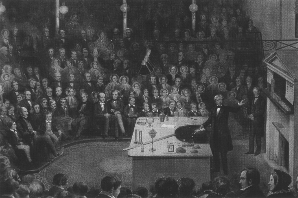
Natural Science - Year II
Unit 62: Cannon and Stellar Types

Science Weblecture for Unit 62
| This Unit's | Homework Page | History Lecture | Science Lecture | Lab | Parents' Notes |
Unit 62: Stellar Classification
For Class
- Topic area: Astronomy
- Terms and concepts to know: Emission Spectrum, Absorption spectrum, magnitude, luminosity, parallax, stellar classification
- See history topics: Biology: Annie's Girls
Lecture:
Classifying Stars
You should recall from our discussion of atomic structure that when an electron changes to a lower energy level, it emits energy E in the form of light at a wavelength hc/ν. The exact amount of energy is determined by the energy levels available to the electron in a particular element or molecular structure, so the wavelengths of light hydrogen gives off differ from the wavelengths of light helium gives off. The emission spectra of a particular glowing hot object like a star or even a tea kettle can tell us what elements are present in it.
Stellar Spectra
Electrons can also absorb energy if they are in a low energy state. Cooler gases in front of hot stars, or the atmosphere of a star itself, will absorb some of the light energy passing through it. The amounts of energy to "jump" to a higher orbit exactly equal the amounts of energy given off when the electron "falls" to a lower orbit, so a dark-line absorption spectrum against a continuous spectrum will also tell us the nature of the elements or molecules absorbing the light.
By looking at the absorption spectra of thousands of stars, we can start ot make some assumptions about the kinds of stars there are in the universe.
Read through the description of stellar classes at the Australian Telescope Education site.
- What is the difference between a continuous spectrum, an emission spectrum, and an absorption spectrum?
The Hertzsprung Russell Diagram
Like the Periodic Table, the Hertzprung-Russell diagram packs a lot of information into a very small space. Spatial layout reveals new information and relationships beyond the absolute data presented.
Read about the HR diagram.
- List the characteristics of the major types of star groups on the HR diagram.
- Find the sun. What kind of star is it? What does its position on the HR diagram tell you about its "life cycle"?
- Find Sirius B. What kind of star is it? What does its position on the HR diagram tell you about its "life cycle"?
- Find Betelgeuse. What kind of star is it? What does its position on the HR diagram tell you about its "life cycle"?
Study/Discussion Questions:
- We can't put stars in a laboratory and do repeatable experiments on them. Does sampling many thousands of stars make up for this limitation? Or is astronomy not a "TRUE" science?
On your own
- Follow some of the links at the bottom of the page at the Australian Telescope site to explore other things spectra can tell us.
© 2005 - 2024 This course is offered through Scholars Online, a non-profit organization supporting classical Christian education through online courses. Permission to copy course content (lessons and labs) for personal study is granted to students currently or formerly enrolled in the course through Scholars Online. Reproduction for any other purpose, without the express written consent of the author, is prohibited.